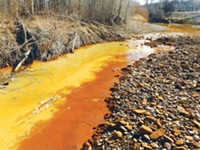Advertisement
Grab your lab coat. Let's get started
Welcome!
Welcome!
Create an account below to get 6 C&EN articles per month, receive newsletters and more - all free.
It seems this is your first time logging in online. Please enter the following information to continue.
As an ACS member you automatically get access to this site. All we need is few more details to create your reading experience.
Not you? Sign in with a different account.
Not you? Sign in with a different account.
ERROR 1
ERROR 1
ERROR 2
ERROR 2
ERROR 2
ERROR 2
ERROR 2
Password and Confirm password must match.
If you have an ACS member number, please enter it here so we can link this account to your membership. (optional)
ERROR 2
ACS values your privacy. By submitting your information, you are gaining access to C&EN and subscribing to our weekly newsletter. We use the information you provide to make your reading experience better, and we will never sell your data to third party members.
Environment
Digging Through New Types Of Waste To Recycle Metals
ACS Meeting News: From sewage sludge to junkyards, scientists explore new ways to mine metals
by Stephen K. Ritter
April 6, 2015
| A version of this story appeared in
Volume 93, Issue 14
Metals are ubiquitous in our lives. There are the metal objects we can see—paper clips, kitchen utensils, electronics, cars or bicycles, wires and pipes, lightbulbs, hammers and shovels. Most of those are not recycled, although they could be.
Wanted: New Ways To Recycle Metals
But then there are personal care products, glass, paint, and tires—things that contain metals but for which there is no ready way to recover the metal, or the metal is abraded and gets scattered in the environment.
Fortunately, some researchers are thinking about the sustainable use of metals. As metal resources are becoming scarce, scientists and engineers are developing strategies and technologies to economically recover metals that go beyond recycling soda cans.

“If we can recover and reuse chemical elements from waste streams, we have the opportunity to decrease reliance on our remaining natural resources and improve sustainability,” said Kathleen S. Smith, a geochemist at the U.S. Geological Survey. Smith was one of hundreds of scientists who spoke on the theme of “Chemistry of Natural Resources” at the American Chemical Society national meeting in Denver held March 22–26.
Smith and others have been examining metal life cycles, thinking about alternative ways of acquiring metals so they don’t have to be freshly mined. Their work comes at a time when global ore quality is slipping, from high-grade, low-bulk ore to low-grade, high-bulk ore, according to the International Council on Mining & Metals. Some economists estimate that we have now extracted more commercially accessible metals out of Earth than are left in our planet. But that may not be a problem.
Instead, it might be an opportunity. Smith and her colleagues are studying whether it’s feasible to mine metals from sewage sludge that accumulates in wastewater treatment plants. Sewage sludge, also known as biosolids, is rich in nitrogen, phosphorus, and organic matter. It also could literally be a gold mine: Gold and other recoverable metals end up in the sludge from industrial processing and consumer products—things that go down the drain, get flushed, or become dust in the wind.
“There are metals everywhere,” Smith said. “Hair care products, detergents, medicines, even nanoparticles that are put in socks to prevent bad odors.” Whatever their origin, these metals end up being funneled through wastewater treatment plants.
The U.S. has about 16,500 wastewater treatment plants that generate some 7 million dry tons of biosolids per year, Smith said. Biosolids are regulated by the Environmental Protection Agency to ensure they are safe to use. The material is treated to wipe out pathogenic microbes and to reduce the amount of nine metals of concern (As, Cd, Cu, Pb, Hg, Mo, Ni, Se, and Zn). About 60% of the material is deemed safe enough to be applied to agricultural land as fertilizer. The remainder is incinerated or sent to landfills, she noted.
If researchers could find ways to recover valuable metals from biosolids while removing the nuisance ones, it would be a win-win, Smith said.

For now, Smith and her team’s mission is to find out exactly what is in our waste and how much. They are building on EPA’s 2009 Targeted National Sewage Sludge Survey, which surveyed for 28 metals among random samples taken from some 3,300 facilities that treat more than 1 million gal of wastewater per day. The survey found potentially valuable amounts of critical elements in sludge—for example, silver up to about 850 mg/kg, and copper up to about 2,600 mg/kg.
Smith and her group hope to pinpoint which wastewater facilities might be most advantageous for recovering metals. So they are collecting biosolids from a range of facilities: ones in semirural communities, in large towns, and in small mountain towns in the Colorado mineral belt.
The USGS researchers are using scanning electron microscopy to examine small metal particles in these biosolids. They also are testing extraction chemicals similar to those used in the mining industry to determine how effective they are at pulling metals out of the sludge. Their preliminary results suggest that the treated waste is enriched with precious metals such as platinum, silver, and gold. “The gold we found was at the level of a minimal mineral deposit,” Smith said. If that amount were in an ore deposit, it might be commercially viable to mine it.
“The next step is to better characterize the form of the metals in biosolids and examine the ease of their extractability,” Smith cautioned. “The economic and technical feasibility of metal recovery from biosolids needs to be evaluated on a case-by-case basis.”
Smith and her colleagues aren’t working in isolation. A team led by Paul Westerhoff of Arizona State University is also looking at metals in sewage sludge through ASU’s Biodesign Institute and its National Sewage Sludge Repository.
Westerhoff and his colleagues recently analyzed biosolids for 58 elements by SEM, inductively coupled plasma mass spectrometry, and energy-dispersive X-ray spectroscopy (Environ. Sci. Technol. 2015, DOI: 10.1021/es505329q). The researchers came up with a list of the 14 most lucrative elements to recover (Ag, Cu, Au, P, Fe, Pd, Mn, Zn, Ir, Al, Cd, Ti, Ga, and Cr), with a combined estimated value of $280 per ton of sludge at current market prices. They concluded that in communities of 1 million or more people, recovered metals in biosolids could be worth $13 million annually. That’s money that could help fuel local economies.
These sludge studies could also help bring awareness to other efforts for recovering metals from alternative sources, Smith told C&EN. Other researchers are exploring developing sorbent materials that can snatch the most valuable metals right out of wastewater or from storm water from highways, parking lots, and roofs. For example, Ian Sofian Yunus and Shen-Long Tsai of National Taiwan University of Science & Technology recently developed a protein-modified cellulosic sorbent for extracting palladium from water (RSC Adv. 2015, DOI: 10.1039/c4ra16200e).
“Although exploring methods to recover metals accumulated in media such as sewage water is not new, the research is providing better information and more accurate estimates of the potential profitability that may derive from urban deposits of metals,” according to Luca Ciacci, a chemist at Yale University’s Center for Industrial Ecology. The work also highlights major hindrances to recovery.
For example, Ciacci, Thomas E. Graedel, and their Yale colleagues just published a study on metals in manufactured products that they described as “lost by design” (Environ. Sci. Technol. 2015, DOI: 10.1021/es505515z). These are typically metals that are dispersed in the environment as the product is in use or incorporated into products in ways for which no viable recycling approach exists, Ciacci told C&EN. Not surprising, many of these uses are associated with the most common objects on the planet—zinc in tires, platinum-group metals in catalytic converters, and titanium dioxide pigment in paint, to name a few.
Catalytic converters, for example, do a good job of zapping pollutants such as hydrocarbons, CO, and NOx and turning them into more benign chemicals such as CO2, H2, and N2. But as cars putt down the road the converters also slowly disperse platinum, palladium, rhodium, cerium, and osmium into the environment. Researchers who have assessed the abundance of the dissipative metals coming from cars in soils along roadways think there is enough there, or will be over time, to make it worthwhile to scoop up the top layer of dirt to recover the metals.
Agro-mining might also prove useful. This plant-based strategy is being promoted by an international team including Antony van der Ent of the Centre for Mined Land Rehabilitation and the University of Queensland, in Australia (Environ. Sci. Technol. 2015, DOI: 10.1021/es506031u). It takes advantage of the fact that certain plants have the ability to selectively accumulate metals at high amounts from soil or water. Reaping, drying, and incinerating the biomass concentrates the metal in the ash, which in the case of remediating toxic metals at mining or industrial sites is often disposed of in landfills. But for agro-mining, the ash is considered a high-grade “bio-ore.”
Van der Ent and his colleagues suggest that agro-mining could provide local communities in developing regions with an alternative use for degraded land and an additional source of income. The communities would farm not for crops, but for metals such as nickel, manganese, and zinc. Nickel in bio-ore, for example, can range from 10 to 25%, compared with only about 2% in low-grade ores.
In addition to sewage sludge and mining waste, piles of electronics and lightbulbs containing metals could be another source to extract metals. Koen Binnemans of the University of Leuven, in Belgium, and coworkers have been using ionic liquid solvents that selectively dissolve metal oxides to separate rare-earth and transition metals during recycling.
Binnemans and his colleague David Dupont recently reported recovering rare-earth metals from stockpiles of discarded neodymium-rich magnets (NdFeB) used in electric motors and from the yttrium and europium phosphor (Y2O3:Eu3+) in extinguished fluorescent lights (Green Chem. 2015, DOI: 10.1039/c4gc02107j and 2014, DOI: 10.1039/c5gc00155b).
But extracting the metals is just the first step in the recovery process. Researchers must also consider how to turn what they extract into a useful form.
What is needed, Smith told C&EN, is to figure out the best form to recover the metals. “That’s where chemists come in, to use innovative chemistry to get the metal in a form, as pure metal or as a metal salt, that can be used to make new products or in smelters. We need to recover the metals in a usable form, or all bets are off.”





Join the conversation
Contact the reporter
Submit a Letter to the Editor for publication
Engage with us on Twitter